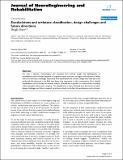| dc.contributor.author | Herr, Hugh M. | |
| dc.date.accessioned | 2010-12-09T20:28:28Z | |
| dc.date.issued | 2009 | |
| dc.identifier.citation | Herr, Hugh. 2009. Exoskeletons and orthoses: classification, design challenges and future directions. Journal of NeuroEngineering and Rehabilitation 6:21. | en_US |
| dc.identifier.issn | 1743-0003 | en_US |
| dc.identifier.uri | http://nrs.harvard.edu/urn-3:HUL.InstRepos:4621865 | |
| dc.description.abstract | For over a century, technologists and scientists have actively sought the development of exoskeletons and orthoses designed to augment human economy, strength, and endurance. While there are still many challenges associated with exoskeletal and orthotic design that have yet to be perfected, the advances in the field have been truly impressive. In this commentary, I first classify exoskeletons and orthoses into devices that act in series and in parallel to a human limb, providing a few examples within each category. This classification is then followed by a discussion of major design challenges and future research directions critical to the field of exoskeletons and orthoses. | en_US |
| dc.language.iso | en_US | en_US |
| dc.publisher | BioMed Central | en_US |
| dc.relation.isversionof | doi:10.1186/1743-0003-6-21 | en_US |
| dc.relation.hasversion | http://www.ncbi.nlm.nih.gov/pmc/articles/PMC2708185/pdf/ | en_US |
| dash.license | LAA | |
| dc.title | Exoskeletons and Orthoses: Classification, Design Challenges and Future Directions | en_US |
| dc.type | Journal Article | en_US |
| dc.description.version | Version of Record | en_US |
| dc.relation.journal | Journal of NeuroEngineering and Rehabilitation | en_US |
| dash.depositing.author | Herr, Hugh M. | |
| dc.date.available | 2010-12-09T20:28:28Z | |
| dash.affiliation.other | HMS^Physical Medicine and Rehabilitation | en_US |
| dc.identifier.doi | 10.1186/1743-0003-6-21 | * |
| dash.contributor.affiliated | Herr, Hugh | |


